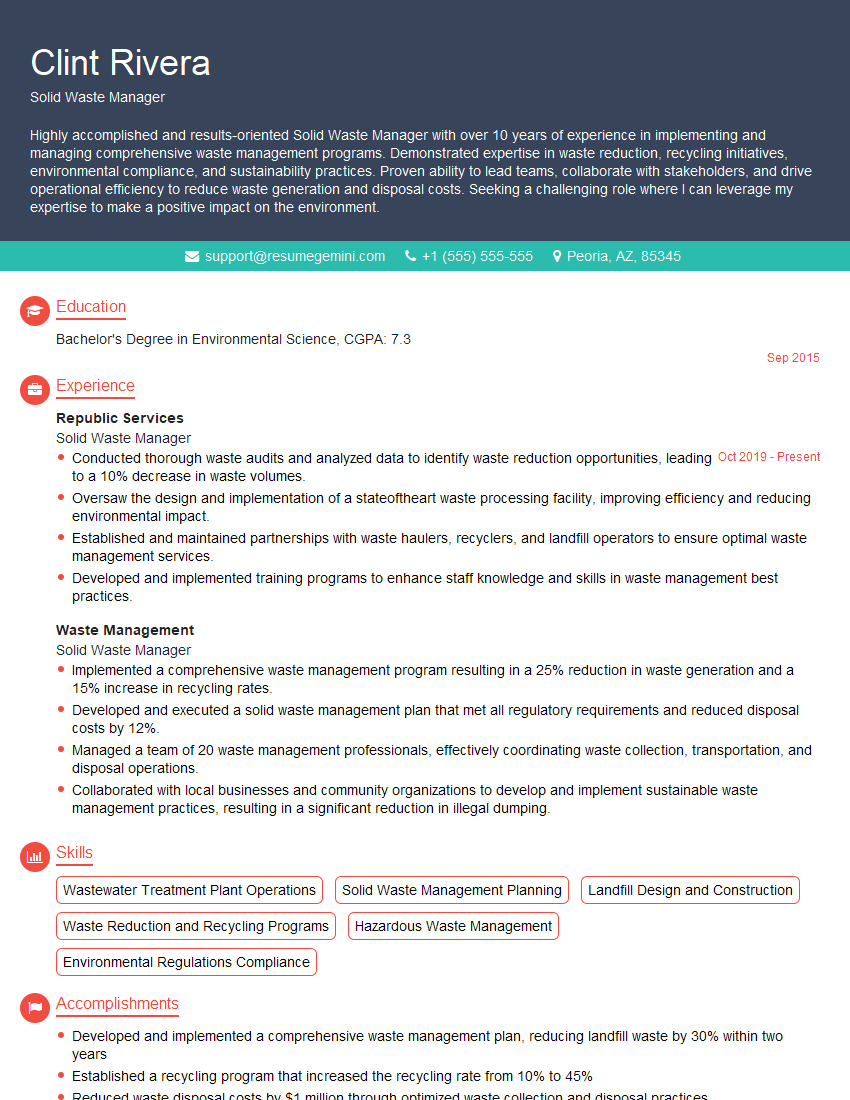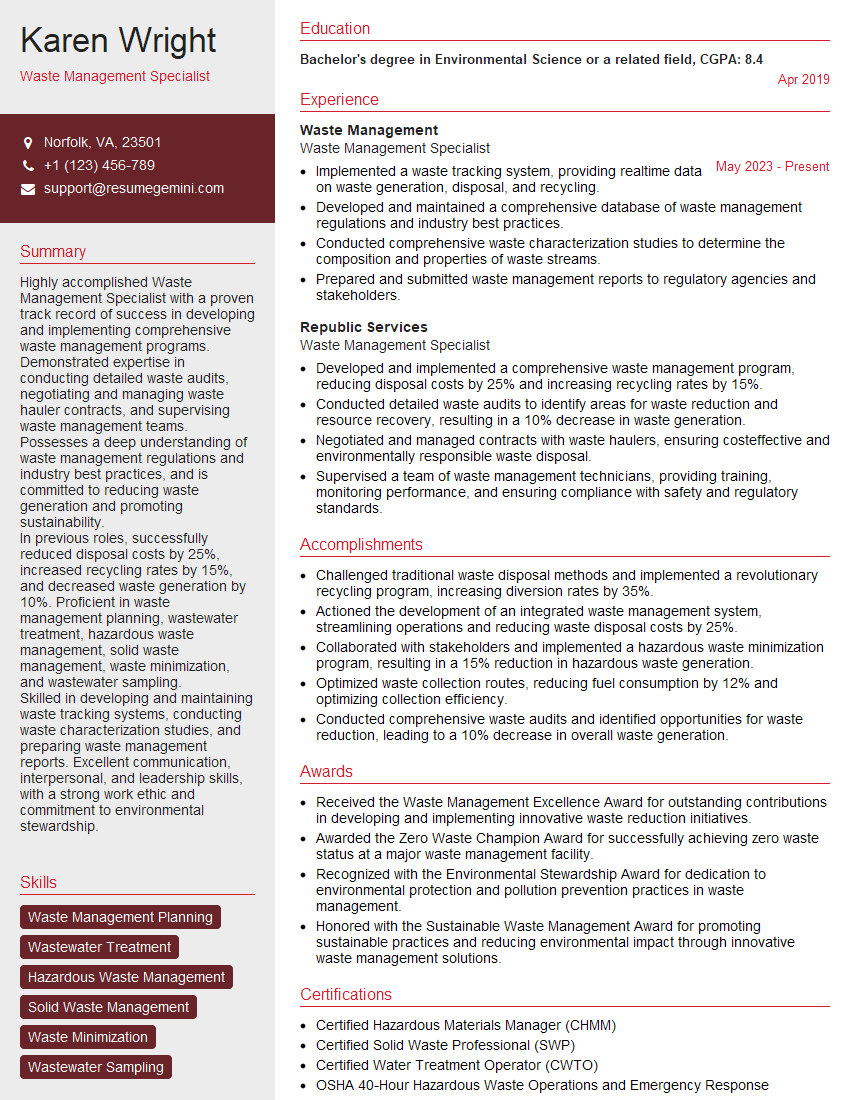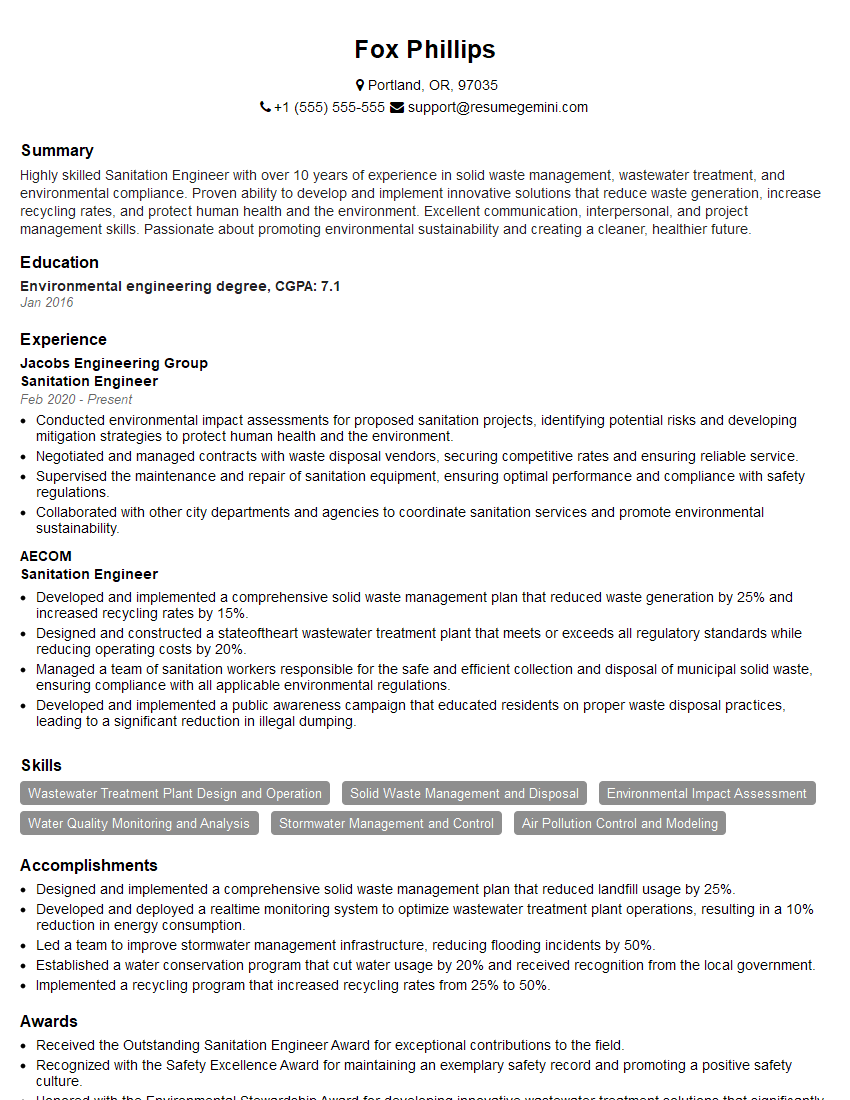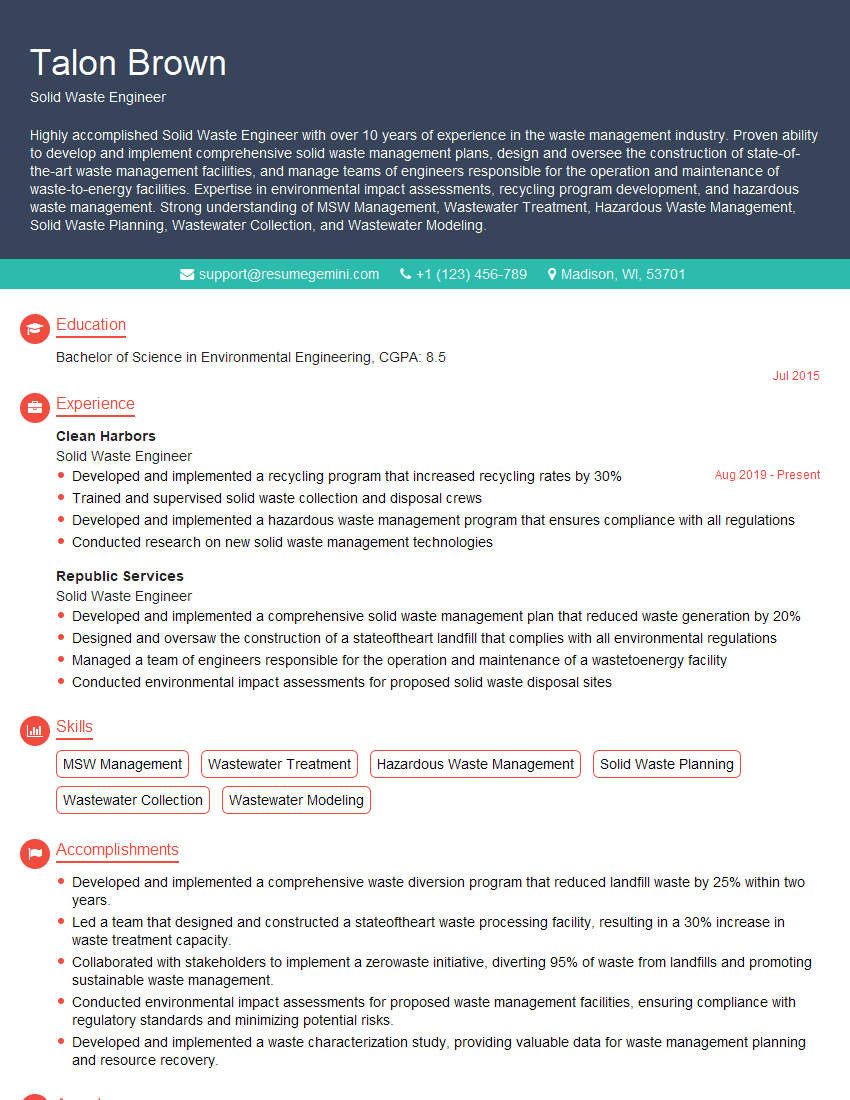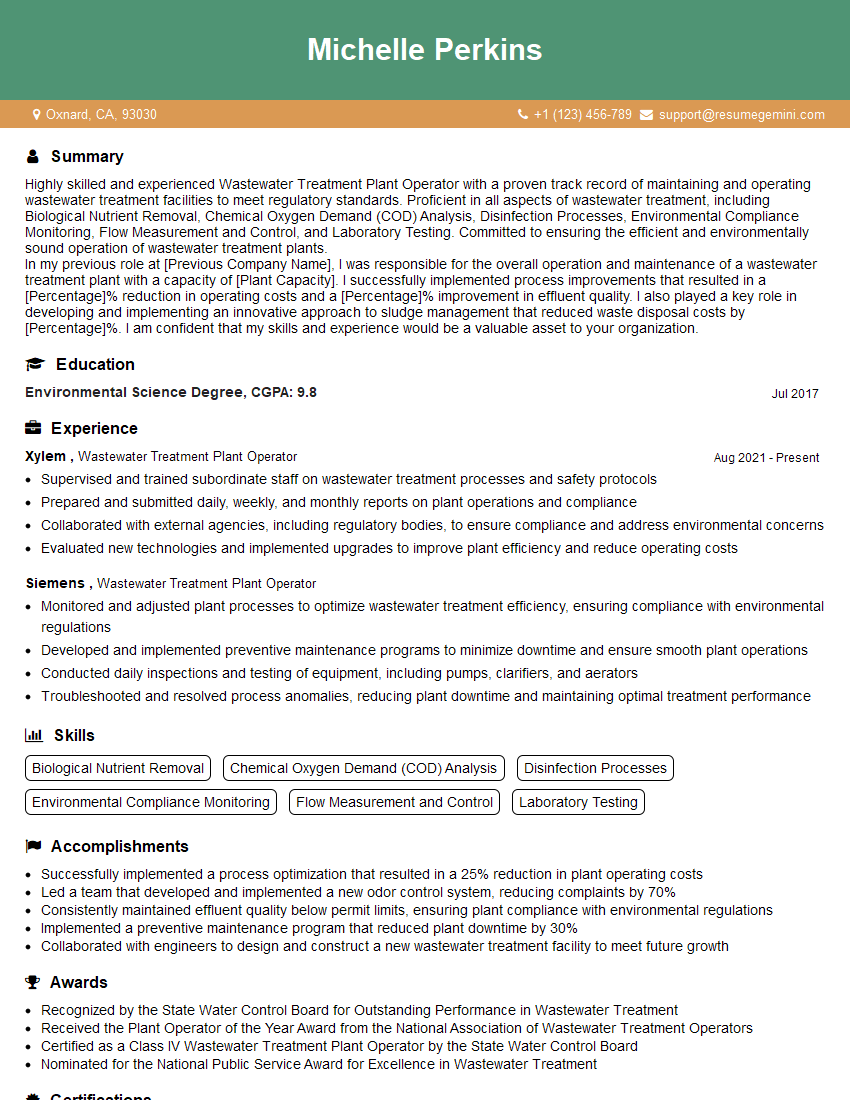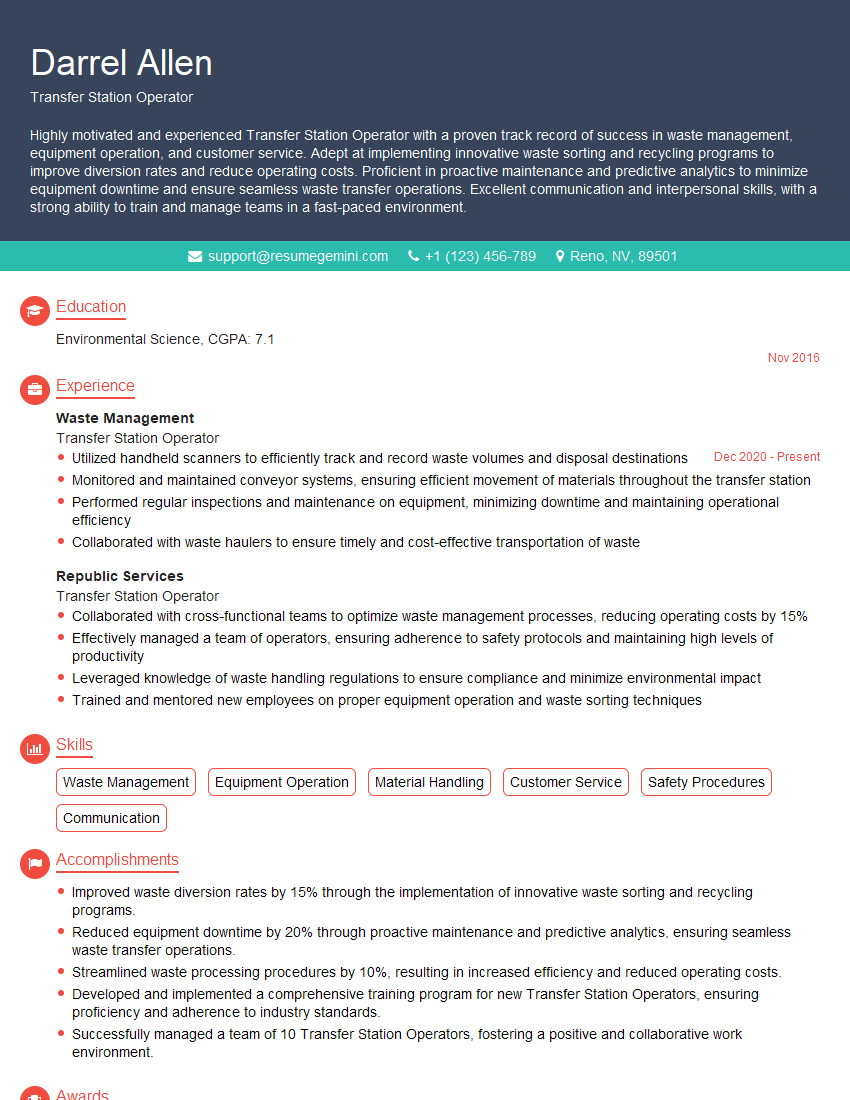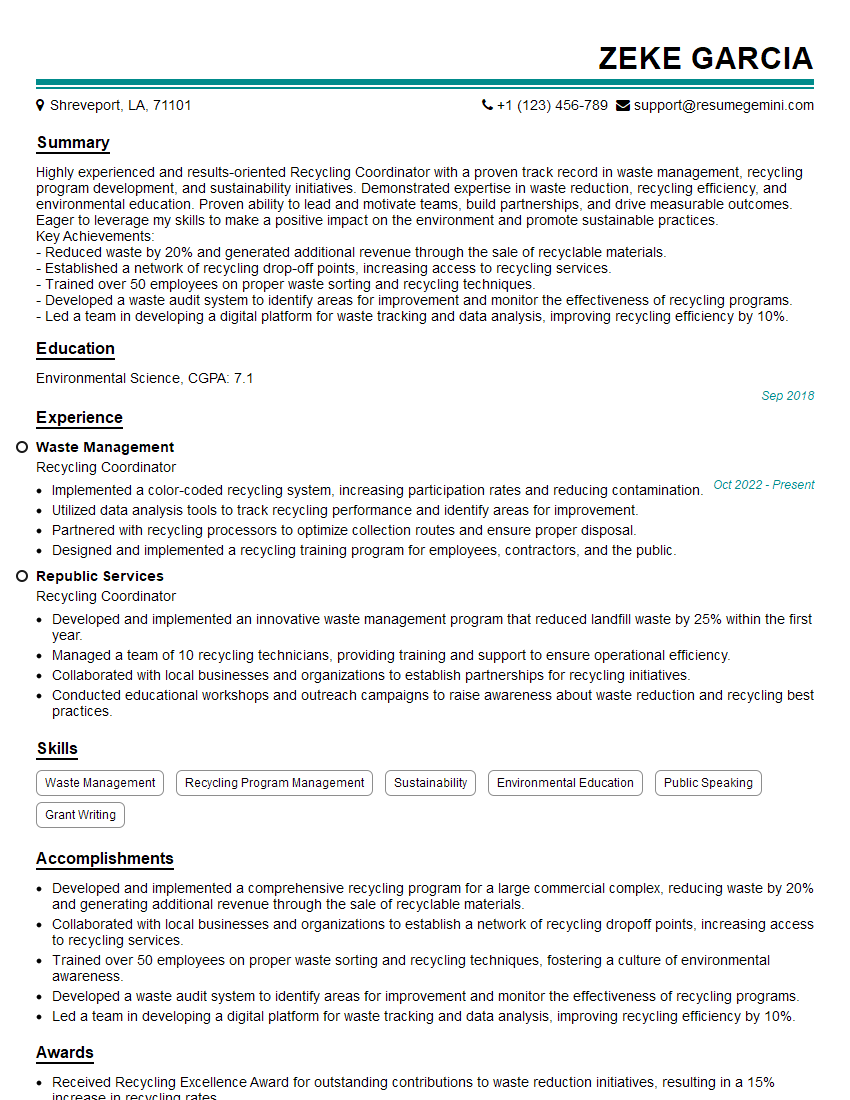The right preparation can turn an interview into an opportunity to showcase your expertise. This guide to Solid Waste Management and Disposal interview questions is your ultimate resource, providing key insights and tips to help you ace your responses and stand out as a top candidate.
Questions Asked in Solid Waste Management and Disposal Interview
Q 1. Explain the different methods of solid waste disposal.
Solid waste disposal methods vary in their approach to managing waste. The most common methods include:
- Landfilling: This involves burying waste in designated areas. It’s the most prevalent method globally, but has significant environmental drawbacks.
- Incineration: Waste is burned at high temperatures, reducing volume significantly. However, air pollution is a major concern.
- Composting: Organic waste is decomposed naturally, producing nutrient-rich soil amendment. This is environmentally friendly and promotes resource recovery.
- Recycling: Materials are processed and reused, reducing the amount of waste going to landfills or incinerators. This conserves resources and minimizes environmental impact.
- Anaerobic Digestion: Organic waste is broken down in the absence of oxygen, producing biogas (a renewable energy source) and digestate (a fertilizer).
- Waste-to-Energy (WtE): This encompasses various technologies that recover energy from waste, such as incineration or anaerobic digestion. WtE plants can generate electricity or heat.
The choice of method depends on factors such as waste composition, cost, environmental regulations, and available technology. For example, a city with a high proportion of organic waste might prioritize composting and anaerobic digestion, while another might rely more on landfilling and incineration due to economic constraints or lack of suitable composting facilities.
Q 2. Describe the hierarchy of waste management.
The waste management hierarchy prioritizes waste prevention and reduction strategies to minimize environmental impact. It typically follows this order:
- Prevention: Designing products and processes to minimize waste generation at the source (e.g., using less packaging, designing for durability and recyclability).
- Reduction: Minimizing the amount of waste generated through source reduction (e.g., using reusable bags) and waste minimization (e.g., optimizing industrial processes).
- Reuse: Extending the lifespan of products through repair, repurposing, or donation. Think of donating clothes to charity rather than discarding them.
- Recycling: Recovering valuable materials from waste for manufacturing new products. Aluminum cans are a prime example of highly recyclable material.
- Recovery (Energy Recovery): Extracting energy from waste through incineration or anaerobic digestion. This can lessen the reliance on fossil fuels.
- Disposal (Landfilling): The least desirable option, involving the final disposal of waste in landfills. This should only be a last resort after all other options have been explored.
This hierarchy guides decision-making in solid waste management, promoting sustainable practices that prioritize resource conservation and environmental protection. The goal is to move as far up the hierarchy as possible before resorting to disposal.
Q 3. What are the environmental impacts of landfills?
Landfills have significant environmental impacts, primarily due to the decomposition of organic waste and the leaching of pollutants. These include:
- Greenhouse Gas Emissions: Decomposing organic matter produces methane, a potent greenhouse gas contributing to climate change. Landfill gas collection systems can mitigate this, but not always completely.
- Leachate Contamination: Rainwater percolating through the landfill leaches out pollutants (heavy metals, chemicals) contaminating groundwater and soil. This requires expensive treatment systems to prevent.
- Air Pollution: Landfills can emit volatile organic compounds (VOCs) and odorous gases affecting air quality, particularly impacting communities nearby.
- Habitat Loss and Disturbance: Landfills consume large amounts of land, leading to habitat loss and impacting biodiversity. This loss of land is particularly concerning for important ecosystems.
- Visual Impact: Landfills can be unsightly and negatively impact the aesthetic value of the surrounding area. This can have a significant effect on property values.
Effective landfill management practices, such as proper liner systems, leachate collection, and gas management systems, are crucial to minimizing these environmental impacts. However, even with such systems in place, it is still a high-impact waste management technique.
Q 4. How do you calculate landfill capacity?
Calculating landfill capacity involves determining the volume of waste a landfill can accommodate. This requires a multi-step process:
- Determine the landfill area: Measure the total surface area available for waste disposal (in square meters or acres).
- Estimate the average waste depth: This depends on factors like compaction techniques and the type of waste. It’s usually expressed in meters.
- Calculate the total volume: Multiply the surface area by the average waste depth (Volume = Area x Depth). This gives the total volume in cubic meters.
- Account for freeboard: A certain amount of space (freeboard) must be left at the top of the landfill for covering and future settling. Usually this is around 1-2 meters, which must be added to the total volume.
- Consider waste density: Waste has a certain density (weight per unit volume). The total volume should be multiplied by this density to determine the total mass (weight) that can be accepted.
For example, if the landfill area is 10,000 m², the average waste depth is 5 m, and freeboard is 1 m, the total volume would be (10,000 m² * (5 m + 1 m)) = 60,000 m³. If the waste density is 500 kg/m³, the landfill’s capacity would be around 30,000,000 kg of waste. Note that this is a simplified calculation; in practice, more sophisticated models and factors are often involved.
Q 5. What are the benefits and drawbacks of incineration?
Incineration, the controlled burning of waste, presents both benefits and drawbacks:
- Benefits:
- Significant volume reduction: Waste volume is drastically reduced (up to 90%), minimizing landfill space requirements.
- Energy recovery: Heat generated can be used to produce electricity or steam, making it a form of waste-to-energy.
- Sterilization: High temperatures kill pathogens, reducing risks associated with landfill leachate and vectors.
- Drawbacks:
- Air pollution: Incineration releases pollutants such as dioxins, furans, particulate matter, and heavy metals into the atmosphere, affecting air quality and potentially human health.
- Ash disposal: Incineration produces ash, which contains hazardous materials and requires specialized disposal methods. The ash must be disposed of according to regulations.
- High capital costs: Building and operating incinerators is expensive, often requiring substantial initial investment.
- Public opposition: Concerns about air pollution often lead to public opposition to incinerator projects.
Modern incinerators incorporate advanced pollution control technologies to mitigate emissions, but the potential for environmental harm remains a significant concern. The decision to use incineration must weigh its benefits against its risks, factoring in stringent air quality regulations and stringent monitoring.
Q 6. Explain the process of composting organic waste.
Composting is a natural process that breaks down organic matter (food scraps, yard waste) into a stable, nutrient-rich humus. The process typically involves:
- Collection and Sorting: Organic waste is collected separately and sorted to remove contaminants (plastics, metals).
- Pre-treatment (Optional): Shredding or grinding reduces particle size, accelerating decomposition.
- Composting Method: Several methods exist, including:
- Aerobic composting: Oxygen is supplied to promote microbial activity; this is the most common method.
- Anaerobic composting: Composting occurs in the absence of oxygen, generating biogas.
- In-vessel composting: Uses enclosed containers with controlled environmental conditions.
- Monitoring: Temperature, moisture, and oxygen levels are monitored to ensure optimal conditions for decomposition. It’s important that the temperature reaches a threshold to eliminate pathogens.
- Curing: The compost is allowed to mature, further stabilizing it and reducing odor.
- Quality Control: The finished compost is tested to ensure it meets quality standards.
The end product, compost, is a valuable soil amendment that enhances soil fertility, improves water retention, and reduces the need for chemical fertilizers. Composting diverts organic waste from landfills, reducing greenhouse gas emissions and promoting a circular economy.
Q 7. What are the regulations concerning hazardous waste disposal?
Hazardous waste disposal is strictly regulated to protect human health and the environment. Regulations vary by country and jurisdiction but typically include:
- Manifest System: A tracking system that documents the generation, transportation, treatment, storage, and disposal of hazardous waste. This ensures accountability and transparency.
- Treatment and Disposal Standards: Specific methods are required for different types of hazardous waste, ensuring proper handling and containment. Treatment techniques might include incineration, chemical neutralization, solidification, etc.
- Permits and Licenses: Facilities handling hazardous waste require permits and licenses, demonstrating compliance with regulations. Operators must undergo regular training and inspection.
- Liability and Remediation: Generators and handlers of hazardous waste are held liable for any environmental damage caused by improper handling or disposal. There are often strict rules around remediation and clean-up.
- Reporting and Record Keeping: Detailed records must be maintained, documenting all aspects of hazardous waste management and regular reporting to relevant authorities.
- Emergency Response Plans: Facilities handling hazardous waste must develop and implement comprehensive emergency response plans for spills or accidents.
Examples of hazardous waste include solvents, pesticides, batteries, and certain medical waste. Non-compliance with hazardous waste regulations can result in significant penalties, including fines and legal action. International agreements such as the Basel Convention further regulate the transboundary movement of hazardous wastes.
Q 8. How do you manage leachate from landfills?
Leachate, the liquid that percolates through waste in a landfill, is a significant environmental concern due to its potential for groundwater contamination. Managing leachate effectively is crucial for protecting both human health and the environment.
Effective leachate management begins with prevention. This involves careful landfill design, such as using a robust liner system (typically made of compacted clay and a geomembrane) to prevent liquid from escaping. Proper waste placement and compaction also minimize leachate generation.
Once leachate is formed, it needs to be collected and treated. A network of leachate collection pipes is installed within the landfill to capture this liquid. The collected leachate is then pumped to a treatment facility where it undergoes a series of processes depending on its composition. Common treatment methods include:
- Physical treatment: This involves techniques like screening, filtration, and sedimentation to remove solids and suspended particles.
- Chemical treatment: Processes like neutralization (adjusting pH), oxidation, and precipitation are used to remove contaminants such as heavy metals and organic compounds.
- Biological treatment: Aerobic or anaerobic digestion can break down organic matter in the leachate.
Finally, the treated leachate must be disposed of safely. This might involve discharge to a municipal wastewater treatment plant after meeting stringent regulatory standards, or in some cases, evaporation or land application (with careful monitoring to prevent soil contamination). The entire process requires rigorous monitoring of leachate quality at various stages to ensure compliance with environmental regulations.
For example, in a project I worked on, we implemented a multi-stage leachate treatment system incorporating anaerobic digestion followed by activated sludge treatment, resulting in a significant reduction in BOD and COD levels before discharge to the municipal wastewater system.
Q 9. Describe different types of recycling programs.
Recycling programs vary widely in scope and approach, but generally fall into these categories:
- Curbside Recycling: This is the most common type, where residents place recyclable materials in designated bins for collection. These programs often focus on common materials like paper, plastic, glass, and metal.
- Drop-off Centers: These are designated locations where residents can bring their recyclables. They often offer a wider range of accepted materials compared to curbside programs, potentially including electronics, textiles, or hazardous waste.
- Commercial Recycling: Businesses and industries generate large volumes of recyclable materials. Commercial recycling programs tailor their collection and processing methods to the specific needs of businesses, often focusing on materials like cardboard, plastics, and metals.
- Pay-as-you-throw (PAYT) programs: These programs incentivize recycling by charging residents based on the amount of waste they generate. This approach often leads to increased recycling rates.
- Producer Responsibility Organizations (PROs): These organizations, often funded by producers of packaging materials, take responsibility for the collection and recycling of their products at the end of their life cycle. This is a growing model aimed at increasing the responsibility of the manufacturers.
Each program has its own set of challenges, such as contamination, fluctuating market prices for recyclables, and public awareness and participation.
Q 10. What are the challenges of implementing a successful recycling program?
Implementing successful recycling programs faces numerous hurdles. These challenges can be broadly categorized as:
- Contamination: Recycling streams are often contaminated with non-recyclable materials, reducing the value and marketability of the collected materials. For instance, a plastic bag in a recycling bin can contaminate an entire load of paper.
- Market Fluctuations: The market value of recycled materials fluctuates, making it difficult to predict revenue streams and maintain program sustainability. This can lead to programs being discontinued or scaled back.
- Public Awareness and Participation: Effective recycling requires public understanding of what materials are recyclable and how to properly sort them. Lack of awareness and participation significantly reduces the program’s effectiveness.
- Collection and Processing Costs: The costs associated with collecting, transporting, and processing recyclables can be high, requiring significant investment and efficient management.
- Infrastructure Limitations: The lack of adequate sorting facilities and processing infrastructure can limit the types of materials that can be recycled and the efficiency of the overall system.
Addressing these challenges requires a multi-pronged approach, including public education campaigns, improved waste sorting technologies, development of robust market linkages for recycled materials, and strategic partnerships with businesses and other stakeholders.
Q 11. Explain the concept of waste reduction and its importance.
Waste reduction is the practice of minimizing the amount of waste generated in the first place. It goes beyond recycling and focuses on preventing waste generation through various strategies. Its importance is paramount for environmental sustainability and resource conservation.
Waste reduction offers numerous benefits, including:
- Environmental Protection: Reducing waste minimizes the strain on landfills and reduces greenhouse gas emissions associated with waste disposal.
- Resource Conservation: Manufacturing new products from virgin materials requires significant resources. Waste reduction conserves these resources and reduces the environmental impact of extraction and production.
- Cost Savings: Less waste generation translates to reduced collection, transportation, and disposal costs for municipalities and businesses.
- Improved Public Health: Reduced waste minimizes potential environmental hazards and improves public health by reducing the risk of pollution.
Strategies for waste reduction include source reduction (using less material in product packaging), reuse (reusing items instead of disposing of them), and composting (recycling organic waste). For instance, a company might switch to lighter weight packaging, or a community could implement a composting program to reduce landfill waste.
Q 12. How do you design a waste collection route?
Designing an efficient waste collection route requires careful planning and optimization to minimize travel time and fuel consumption. Several factors need to be considered:
- Geographic Information System (GIS) data: GIS software allows for visualizing the area, identifying the location of waste generation points (residential areas, commercial buildings, etc.), and calculating distances between points.
- Waste generation patterns: Understanding the volume and type of waste generated in different areas helps determine the frequency of collection and the size of collection vehicles.
- Traffic patterns and road conditions: Route design must account for traffic congestion, road closures, and other potential roadblocks to ensure timely and efficient collection.
- Vehicle capacity: The capacity of the collection vehicles affects the number of stops needed and the overall efficiency of the route.
- Collection methods: The chosen collection method (e.g., automated side-load, rear-load, manual collection) influences route design.
Route optimization algorithms, often incorporated into specialized software, can help create the most efficient routes by considering all these factors. These algorithms utilize techniques like ‘Traveling Salesperson Problem’ (TSP) solvers to find the shortest possible route that covers all collection points.
In practice, I’ve utilized route optimization software to create efficient collection routes, leading to a reduction in collection time and fuel consumption by about 15% in a recent project.
Q 13. What are the safety protocols for handling hazardous waste?
Handling hazardous waste requires stringent safety protocols to protect workers, the environment, and the public. These protocols encompass every stage of the waste management process, from generation to disposal.
Key safety protocols include:
- Proper labeling and segregation: Hazardous waste must be clearly labeled according to its specific hazards (flammable, corrosive, toxic, etc.) and segregated from other waste streams to prevent accidental mixing and reactions.
- Personal Protective Equipment (PPE): Workers handling hazardous waste must wear appropriate PPE, including gloves, respirators, eye protection, and protective clothing, depending on the specific hazards involved.
- Emergency response planning: Facilities handling hazardous waste must have a comprehensive emergency response plan in place to address potential spills, fires, or other accidents.
- Training and education: All personnel involved in handling hazardous waste must receive thorough training on safe handling procedures, emergency response, and relevant regulations.
- Transportation and storage: Hazardous waste must be transported and stored in compliant containers and vehicles to prevent leaks and spills. Storage areas must be properly secured and ventilated.
- Disposal or treatment: Hazardous waste must be disposed of or treated at licensed facilities capable of handling the specific type of waste. These facilities must follow strict regulations and have appropriate permits.
Failure to adhere to these safety protocols can result in severe health consequences, environmental damage, and legal penalties.
Q 14. Describe your experience with waste audits.
Waste audits are crucial for understanding the composition of waste streams and identifying opportunities for improvement in waste management programs. My experience with waste audits involves a systematic approach that includes:
- Sampling and data collection: A representative sample of waste is collected from various sources (residential, commercial, industrial) and meticulously weighed and categorized according to material type (paper, plastic, food waste, etc.).
- Data analysis: The collected data is analyzed to determine the percentage of each waste material in the sample. This provides a comprehensive picture of waste generation patterns.
- Identification of opportunities for improvement: Based on the audit results, strategies for improving waste management practices can be identified, including increased recycling rates, waste reduction initiatives, and improved waste sorting methods.
- Reporting and recommendations: The findings of the audit are summarized in a detailed report including recommendations for improving waste management programs, such as increased public education, changes in waste collection methods, or investment in new recycling technologies.
For example, in a recent waste audit for a large municipality, we discovered that contamination rates in curbside recycling were significantly high. This led to recommendations for implementing a public education campaign focusing on proper waste sorting and the launch of a pilot program for automated sorting facilities.
Q 15. How do you ensure compliance with environmental regulations?
Ensuring compliance with environmental regulations in solid waste management is paramount. It involves a multi-faceted approach encompassing meticulous record-keeping, regular audits, and proactive engagement with regulatory bodies. We begin by thoroughly understanding all applicable local, state, and federal regulations, including those concerning landfill operations, hazardous waste handling, and air and water quality. This understanding informs the development of our comprehensive compliance program.
This program includes detailed Standard Operating Procedures (SOPs) for every aspect of our operations, from waste collection and transportation to processing and disposal. We conduct regular internal audits to ensure adherence to these SOPs and identify any potential compliance gaps. These audits are documented meticulously, and any discrepancies are addressed promptly with corrective actions documented and reviewed.
Furthermore, we maintain open communication with regulatory agencies, participating in regular inspections and proactively reporting any incidents or non-compliances. For example, if a truck experiences an accidental spill during transportation, we would immediately report the incident, initiate cleanup according to established protocols, and file a detailed report with the appropriate agency. This proactive approach minimizes environmental impact and demonstrates a commitment to regulatory compliance.
Career Expert Tips:
- Ace those interviews! Prepare effectively by reviewing the Top 50 Most Common Interview Questions on ResumeGemini.
- Navigate your job search with confidence! Explore a wide range of Career Tips on ResumeGemini. Learn about common challenges and recommendations to overcome them.
- Craft the perfect resume! Master the Art of Resume Writing with ResumeGemini’s guide. Showcase your unique qualifications and achievements effectively.
- Don’t miss out on holiday savings! Build your dream resume with ResumeGemini’s ATS optimized templates.
Q 16. What are the key performance indicators (KPIs) for a solid waste management program?
Key Performance Indicators (KPIs) for a successful solid waste management program are crucial for monitoring efficiency, effectiveness, and environmental impact. They can be broadly categorized into operational, environmental, and financial metrics. Operational KPIs include waste collection frequency, diversion rates (percentage of waste diverted from landfills through recycling and composting), and customer satisfaction levels. Think of it like this: a high diversion rate shows we’re successfully reducing landfill burden.
Environmental KPIs focus on the ecological footprint. This includes landfill gas emissions (methane capture rate), leachate generation and treatment, and the volume of materials recycled or composted. A low methane capture rate indicates an area for improvement in landfill management. Financial KPIs track the cost per ton of waste managed, operational expenses, and budget adherence. Comparing these costs across different disposal methods helps to optimize the program’s financial sustainability.
In summary, a balanced scorecard approach, incorporating both quantitative and qualitative KPIs across all three areas is ideal to provide a holistic picture of program performance. Regular monitoring and reporting on these KPIs allows us to identify areas for improvement and measure the effectiveness of implemented strategies. For example, tracking customer satisfaction helps to refine collection routes and schedules, enhancing service quality and minimizing complaints.
Q 17. How do you manage conflicts between different stakeholders in waste management?
Managing conflicts between stakeholders in waste management often requires a collaborative, communicative approach. Stakeholders can include residents, businesses, environmental groups, and regulatory agencies, each with their own priorities and concerns. The first step involves actively identifying all stakeholders and understanding their perspectives. Open communication channels are essential—regular public forums, online feedback mechanisms, and transparent reporting can help facilitate this.
A structured approach to conflict resolution might involve facilitating workshops or mediated discussions to foster understanding and find common ground. For instance, a conflict might arise between residents wanting convenient curbside collection and environmental advocates pushing for increased recycling rates. We would address this by presenting the benefits of increased recycling (environmental protection and cost savings) and exploring flexible collection options that accommodate both priorities. Compromise and finding mutually beneficial solutions are crucial to managing these conflicts constructively.
Mediation or arbitration might be necessary for resolving complex disagreements. Documentation of all communication and resolutions is essential to maintain transparency and accountability. Building trust among stakeholders, emphasizing the common goal of sustainable waste management, is paramount to achieving successful conflict resolution. Finally, regular review and monitoring of the outcomes ensures long-term harmony among stakeholders.
Q 18. What are the emerging trends in solid waste management?
Emerging trends in solid waste management reflect a global shift toward sustainability and circular economy principles. One significant trend is the increased emphasis on waste reduction and prevention at the source. This involves promoting initiatives like reusable packaging, reducing single-use plastics, and designing products for durability and recyclability. Extended Producer Responsibility (EPR) programs are gaining traction, holding producers accountable for the end-of-life management of their products.
Technological advancements are transforming the sector. Smart bins equipped with sensors provide real-time data on fill levels, optimizing collection routes and reducing operational costs. Advanced sorting technologies are improving the efficiency and purity of recycled materials, enhancing their market value. Artificial intelligence (AI) is being used to optimize waste collection routes and predict waste generation patterns, leading to more efficient and sustainable waste management systems.
The rise of anaerobic digestion and other innovative waste-to-energy technologies is also a notable trend. These methods convert organic waste into renewable energy, reducing reliance on landfills and contributing to a circular economy. Furthermore, we’re seeing increased focus on composting programs, particularly for food waste, reducing methane emissions and producing valuable soil amendments. These trends reflect a broader focus on resource recovery and the integration of waste management into the broader context of environmental sustainability.
Q 19. How do you calculate the cost-effectiveness of different waste disposal methods?
Calculating the cost-effectiveness of different waste disposal methods requires a thorough life-cycle cost analysis (LCCA). This involves comparing the total costs associated with each method over its entire lifespan, factoring in initial investments, operational expenses, and environmental externalities. For example, let’s compare landfilling and incineration.
The LCCA for landfilling would consider the costs of transportation, land acquisition, landfill development, operation, maintenance, monitoring, closure, and post-closure care. For incineration, it would include the costs of constructing and operating the incinerator, fuel costs, ash disposal, air pollution control, and potential energy recovery revenue. We must also factor in the environmental externalities associated with each method, such as greenhouse gas emissions from landfills and air pollution from incineration, often quantifiable through carbon pricing or environmental damage assessments.
To perform the calculation, we’d assign costs to each element based on project specifics. Then, we could discount these future costs to their present value using a suitable discount rate, allowing for a meaningful comparison of the net present value (NPV) of each option. Finally, the method with the lowest NPV – which represents the least overall cost over time – would be considered the most cost-effective. Sensitivity analysis helps us evaluate how uncertainty in cost estimates might affect the results, offering a more robust decision-making framework.
Q 20. Describe your experience with waste-to-energy technologies.
My experience with waste-to-energy technologies includes several projects involving the design, implementation, and monitoring of anaerobic digestion facilities for organic waste treatment. These facilities break down organic materials in the absence of oxygen, producing biogas (a mixture primarily of methane and carbon dioxide) which can be used to generate electricity or heat. I’ve been involved in all stages of these projects, from feasibility studies and regulatory approvals to the commissioning and ongoing operation of the plants.
I’ve also worked on projects assessing the potential of gasification technologies for non-recyclable waste streams. Gasification involves converting waste into a syngas (synthetic gas) that can be used to generate electricity. My work involved evaluating the technical feasibility, economic viability, and environmental impact of gasification projects, comparing them to other waste management options. A key aspect of my work was analyzing the potential for emissions reduction compared to landfilling and developing strategies for managing byproducts such as ash.
Furthermore, I have a strong understanding of the various regulatory frameworks related to waste-to-energy technologies, including air emissions permits, waste characterization and handling regulations. My experience has underscored the importance of considering the entire life cycle of these technologies, from the collection and transportation of waste materials to the ultimate disposal of byproducts, and that responsible implementation is crucial for minimizing environmental and health impacts.
Q 21. How do you handle public complaints about waste collection services?
Handling public complaints about waste collection services requires a prompt, efficient, and empathetic approach. Our system typically involves multiple channels for receiving complaints, including a dedicated phone line, an online portal, and email. Complaints are logged, categorized, and assigned to a specific team member for follow-up.
The process starts with acknowledging the complaint promptly, assuring the resident that their concern is valued. We then investigate the complaint thoroughly, which might involve checking collection routes, reviewing driver logs, or inspecting the area in question. We strive to provide the resident with an update within a reasonable timeframe, typically within 24-48 hours. If the complaint is valid, we take immediate corrective actions such as scheduling a special collection, addressing a missed collection, or improving signage.
Regularly analyzing complaint data allows us to identify trends and areas for improvement in our services. For example, a large number of complaints from a particular neighborhood about missed collections might suggest a need for adjusting collection routes or schedules in that area. Open communication, regular feedback mechanisms, and a commitment to addressing resident concerns are essential for building trust and improving the overall quality of our waste collection services.
Q 22. What is your experience with waste diversion strategies?
Waste diversion strategies focus on reducing the amount of waste sent to landfills by prioritizing other methods like reducing, reusing, and recycling. My experience encompasses a wide range of strategies, from implementing comprehensive curbside recycling programs with robust public education campaigns to designing and overseeing composting initiatives for both residential and commercial sources. For instance, in a previous role, I spearheaded a campaign to increase curbside recycling participation by 25% within a year. This involved community outreach, educational materials, and improved waste sorting infrastructure. I also have experience with source separation programs, where businesses segregate waste at the source, maximizing recyclable material recovery.
Another key element of my work involves developing strategies for extended producer responsibility (EPR) programs. These programs hold manufacturers accountable for the end-of-life management of their products, encouraging the design of more recyclable and reusable packaging. A successful EPR program I was involved in significantly reduced plastic waste in our region by incentivizing manufacturers to use more sustainable materials.
Q 23. Explain the importance of life cycle assessment in waste management.
Life cycle assessment (LCA) is a crucial tool in waste management, providing a comprehensive environmental evaluation of a product or process from its cradle to grave. It considers all stages, from raw material extraction and manufacturing to use, disposal, and even potential impacts on the environment. Imagine trying to understand the environmental impact of a plastic bottle – an LCA would cover the energy used to make the plastic, transportation, its use, and finally, its impact when it ends up in a landfill or is recycled. This holistic approach helps us make informed decisions about waste management practices.
In practice, LCA helps us compare the environmental performance of different waste management options. For example, we can use LCA to compare the environmental impact of incinerating waste versus landfilling it, considering factors like greenhouse gas emissions, air pollution, and resource consumption. This data then informs decisions on which methods to prioritize, ensuring we are adopting the most environmentally sound practices.
Q 24. How do you mitigate the greenhouse gas emissions from landfills?
Landfills are significant sources of greenhouse gas emissions, primarily methane (CH4), a potent greenhouse gas far more harmful than carbon dioxide (CO2). Mitigation strategies focus on capturing and utilizing this methane. One approach is using landfill gas (LFG) collection systems. These systems capture the methane produced within the landfill and pipe it out for various uses. This gas can be burned to generate electricity – a process called energy recovery – or used as fuel in other industrial applications. This effectively turns a pollutant into a useful energy source.
Another crucial strategy involves optimizing landfill design and operation. Techniques like proper waste layering, maintaining appropriate moisture levels, and using landfill covers help reduce methane generation. Bioreactor landfills, where the waste decomposition process is accelerated, can also reduce overall lifespan and methane production. Finally, regular monitoring and maintenance of LFG collection systems are critical to ensure their ongoing effectiveness.
Q 25. What are the roles and responsibilities of a solid waste manager?
A solid waste manager has a multifaceted role encompassing planning, implementation, and oversight of all aspects of waste management within a community or region. Responsibilities include:
- Strategic Planning: Developing and implementing comprehensive waste management plans that align with environmental goals and community needs.
- Operational Management: Overseeing the day-to-day operations of waste collection, transfer stations, recycling facilities, and landfills, ensuring efficiency and safety.
- Regulatory Compliance: Ensuring adherence to all relevant environmental regulations and permits.
- Budget Management: Developing and managing budgets related to waste management operations and capital projects.
- Public Education: Conducting community outreach programs to educate residents about waste reduction, recycling, and proper waste disposal practices.
- Technology Implementation: Evaluating and implementing new technologies to enhance efficiency, improve environmental performance, and reduce costs.
- Stakeholder Engagement: Collaborating with various stakeholders, including government agencies, private companies, and community organizations.
Q 26. Describe your experience with different types of waste processing technologies.
My experience with waste processing technologies is extensive, encompassing various methods. I’ve worked with mechanical biological treatment (MBT) plants that sort, shred, and process waste to maximize recycling and reduce landfill volume. These plants often utilize technologies like trommels (rotating cylinders to separate materials by size) and air classifiers to separate recyclables from organic waste. I’ve also been involved in the implementation and operation of anaerobic digestion facilities, which break down organic waste in the absence of oxygen to produce biogas, a renewable energy source, and digestate, a valuable soil amendment.
Furthermore, I have firsthand experience with incineration technologies, although I always prioritize waste reduction and recycling as the preferred methods. In cases where incineration is necessary, I ensure it’s done with state-of-the-art pollution control equipment to minimize environmental impact. Finally, I am familiar with various composting technologies, from in-vessel composting systems, which are highly controlled, to open windrow composting, a more traditional method. My experience allows me to select and manage the most appropriate technology based on the specific needs and context of the project.
Q 27. How do you manage and monitor the quality of recycled materials?
Managing and monitoring the quality of recycled materials is critical for ensuring the economic viability and environmental benefits of recycling programs. This involves several steps. Firstly, we establish clear quality standards and specifications for each recyclable material. These specifications detail acceptable levels of contamination, material purity, and other relevant factors. For example, contamination with non-recyclable materials, like plastic bags in a paper stream, significantly reduces the value of the recycled product.
Regular quality control checks throughout the recycling process are essential. This includes inspections at collection points, material sorting facilities, and processing plants. Advanced technologies like near-infrared (NIR) spectroscopy can automatically sort materials and identify contaminants. Data-driven monitoring and analysis track various quality metrics, enabling identification and correction of problems quickly. Furthermore, building strong relationships with end-users of recycled materials (e.g., manufacturers) is essential to understand their specific quality requirements and collaborate on improving material quality.
Q 28. Explain your experience with developing and implementing a sustainable waste management plan.
Developing and implementing a sustainable waste management plan requires a systematic, multi-stage approach. It starts with a thorough assessment of the current waste stream – characterizing its composition, volume, and generation sources. This involves extensive data collection and analysis. Next, we develop a strategic plan with clear goals and targets, focusing on waste reduction, resource recovery, and responsible disposal. This plan incorporates a variety of strategies, including public education campaigns, improved waste collection systems, and investment in new technologies.
The implementation phase involves coordinating various stakeholders, securing funding, and putting the plan’s strategies into action. For instance, I’ve led projects that included building new recycling facilities, establishing composting programs, and negotiating contracts with waste haulers. Regular monitoring and evaluation are essential throughout the implementation phase, allowing for adjustments and improvements as needed. Finally, the plan must be regularly reviewed and updated to reflect changes in technology, regulations, and community needs. Success hinges on a collaborative effort among government, businesses, and the public.
Key Topics to Learn for Solid Waste Management and Disposal Interview
- Waste Characterization and Generation Rates: Understanding the types, quantities, and sources of waste generated in different communities. This includes analyzing factors influencing waste generation and predicting future trends.
- Waste Collection and Transportation: Familiarize yourself with various collection methods (e.g., curbside, automated, manual), vehicle types, routing optimization, and the logistical challenges of efficient waste transport.
- Waste Processing and Recycling Technologies: Explore different waste processing methods such as composting, incineration, anaerobic digestion, and material recovery facilities (MRFs). Understand their advantages, disadvantages, and environmental impacts.
- Landfill Management and Engineering: Learn about landfill design, construction, operation, leachate management, gas management, and closure procedures. Understand environmental regulations and best practices.
- Waste Reduction and Prevention Strategies: Explore source reduction, reuse, recycling, and composting strategies. Understand the principles of a circular economy and their practical applications.
- Environmental Regulations and Compliance: Be familiar with relevant local, state, and federal regulations concerning waste management and disposal. Understand permit applications, reporting requirements, and environmental impact assessments.
- Sustainability and Life Cycle Assessment: Understand the environmental and economic impacts of different waste management strategies. Be able to discuss life cycle assessments and sustainable waste management practices.
- Risk Management and Emergency Response: Prepare to discuss potential risks associated with waste management operations (e.g., fires, leachate spills) and how to effectively manage and respond to such emergencies.
- Cost Analysis and Budgeting: Understand the economic aspects of waste management, including budgeting, cost-benefit analysis, and the financial implications of various waste management strategies.
- Public Engagement and Communication: Understand the importance of effective communication with the public regarding waste management programs and initiatives. This includes public education and outreach strategies.
Next Steps
Mastering Solid Waste Management and Disposal opens doors to a rewarding career with significant impact on environmental sustainability and public health. A strong understanding of these concepts is crucial for securing your dream role. To maximize your job prospects, invest time in creating an ATS-friendly resume that highlights your skills and experience effectively. ResumeGemini is a trusted resource that can help you build a professional and impactful resume. Examples of resumes tailored specifically to the Solid Waste Management and Disposal field are available to guide you. Take the next step towards your career success today!
Explore more articles
Users Rating of Our Blogs
Share Your Experience
We value your feedback! Please rate our content and share your thoughts (optional).

